Submission to the Productivity Commission Inquiry into Competition in the Financial System 5. Deposits, Mortgages and SME Lending
- Download 970KB
This section examines competition in the markets specifically identified in the Inquiry's Terms of Reference – deposits, mortgage lending and SME lending.
Deposits
Financial market conditions and banks' access to wholesale funding markets have a large impact on deposit markets. As a result of these factors, competition for deposits intensified during the financial crisis, despite the market becoming more concentrated. As the supply of funding in wholesale markets increased over recent years, competition for deposits has eased, although there are indications that a relatively high degree of competition has persisted. Some indicators of this include the high price of deposits relative to other forms of funding, low levels of fee income derived from deposits and a high level of investment in payment services that are attached to transactional deposits. Regulatory developments, such as the introduction of the FCS and Basel liquidity standards, have also bolstered competition for deposits. There are, nonetheless, some features of deposit markets that indicate the strength of competition varies across products and across customers. These include the entry of foreign banks into wholesale but not retail deposit markets, pricing structures for retail deposits that favour new over existing depositors and the prevalence of bundling.
Developments since the financial crisis
Financial market conditions have a large impact on deposit markets (Graph 20). The tighter supply of funding in wholesale markets and a push by creditors for banks to shift to longer-term and more stable sources of funding during the global financial crisis resulted in greater demand for domestic deposits, particularly from the major banks. In the post-crisis period, the funding composition of banks continued to shift significantly towards deposits. This was partly a result of a change in the preferences of depositors, as they shifted out of poorly performing assets. Banks also attracted deposits by increasing interest rates (Graph 21). The average interest rate paid on deposits relative to the cash rate rose by around 2 percentage points from their level prior to the crisis, to be just below the level of the cash rate.
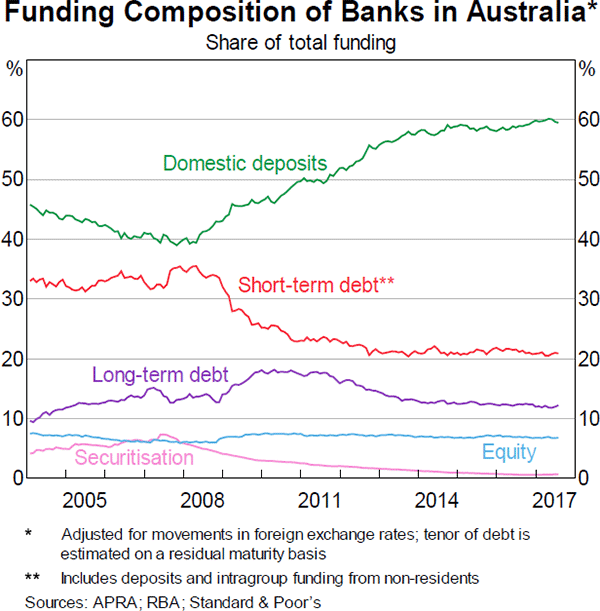
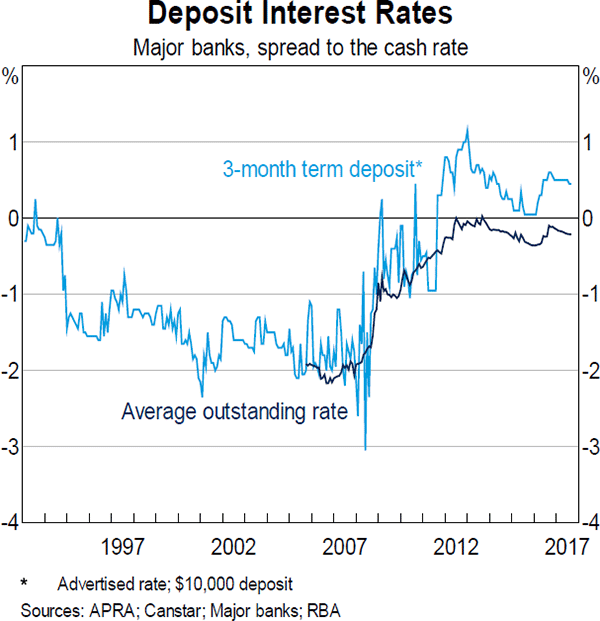
However, since 2013 banks' access to wholesale funding markets has improved, meaning that banks' need to compete for deposits has reduced somewhat. This can be seen most clearly in the decline in the indicative deposit rate relative to money market rates, although the differential remains higher than before the financial crisis (Graph 22).
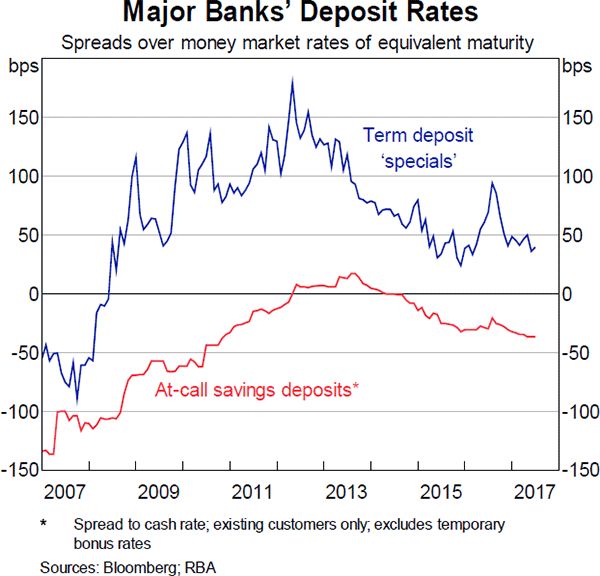
New entrants
The entry of new banks following the Wallis Inquiry resulted in an intensification of competition in deposit markets, notably through foreign banks competing for the provision of online deposits. These products have remained in the market, although many banks have also maintained branch networks to collect deposits.
In the absence of further new entry in the retail deposit market, the major banks have taken a larger market share of the deposit market since the financial crisis (Graph 23). Part of this increase in share is due to the acquisition of smaller ADIs, but it is also in part cyclical. Further, there appear to be greater natural and regulatory barriers to entry in the retail deposit market than in the wholesale market, such as the need to set up a subsidiary, establish a brand and meet other regulatory requirements.
While it is more difficult for foreign bank entrants to compete for retail deposits, they are able to raise wholesale deposits (restricted to these by their licences) and have gained some market share in this segment (Graph 24). However, because they also have access to other funding options, including their parent entities, their demand for Australian dollar wholesale deposit funding is limited.
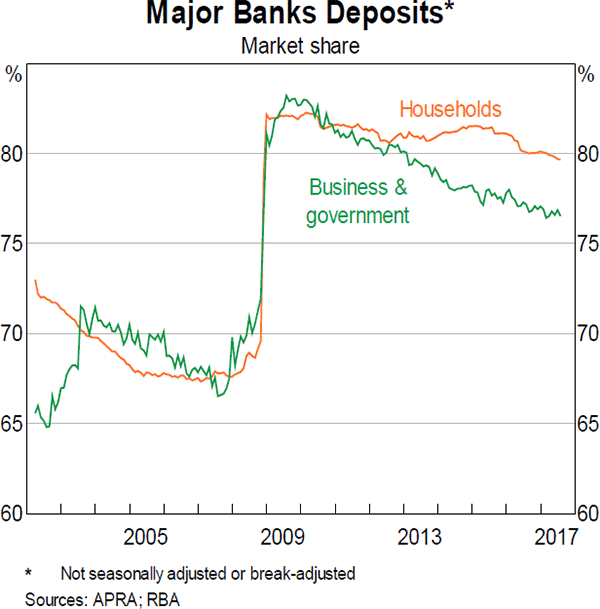
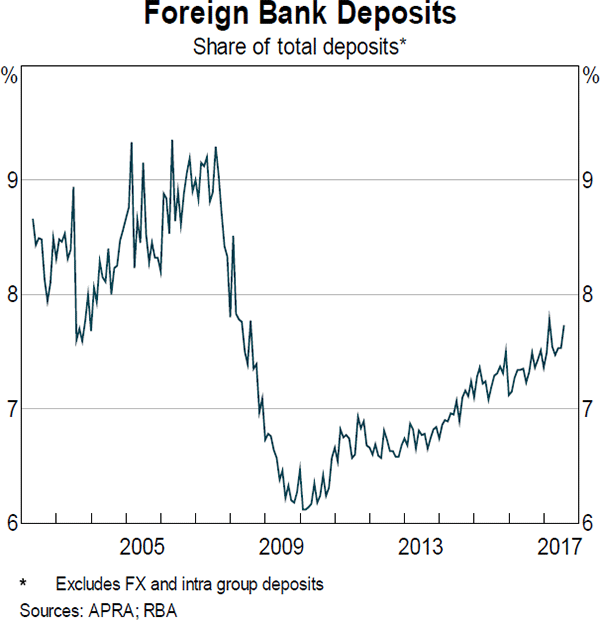
Price competition
In addition to cyclical forces, deposit pricing is influenced by the liquidity of deposits. Banks face liquidity risk because the maturity of their liabilities, including deposits, is shorter than the maturity of their assets, such as loans.
Banks pay higher interest rates on deposits that expose them to less liquidity risk – that is, those that are more stable and less likely to be withdrawn by the depositor (Table 2). Among other factors, this is influenced by type of depositor (wholesale or retail), the term to maturity (at-call or term) and the purpose of the deposit (savings or transactional). The relative interest rates on deposits have also recently been influenced by liquidity regulations, which treat retail (households, small businesses and self-managed superannuation funds) and longer maturity deposits as more stable than other deposit types (Atkin and Cheung 2017). These regulations will tend to lead to differentiation in pricing across deposit types. Offsetting this to some degree is the fact that there appears to have been less price differentiation within some deposit categories since the financial crisis. This is consistent with stronger deposit competition over this period (RBA 2014b).
ADIs that have access to the different segments of the deposit market can substitute between them, at least to some degree. For example, the major banks have the greatest capacity to substitute since they can raise deposits in most segments of the deposit market. This substitutability ensures that the interest rates on most deposits tend to move together.
Retail depositors' ability to assess which ADIs are offering the best deals in deposit markets has improved as comparison websites have developed. Furthermore, there is transparency in the terms and conditions that retail customers receive. Nevertheless, there are also pricing structures, such as introductory rates and temporary specials, which favour new over existing customers. These pricing structures are indicative of banks' response to customer inertia.
| Transaction Per cent | Savings Per cent | Term Per cent | Total $ billion | Share Per cent | |
|---|---|---|---|---|---|
| Household | 21 | 13 | 13 | 865 | 47 |
| Business | 13 | 4 | 12 | 534 | 29 |
| Superannuation | 3 | 3 | 5 | 225 | 12 |
| Government | 2 | 0 | 2 | 77 | 4 |
| Other financial institutions | 2 | 2 | 3 | 121 | 7 |
| Total(a) | 42 | 23 | 36 | 1821 | 100 |
|
(a) Excludes intragroup, bank and other ADI deposits Sources: APRA; RBA |
|||||
Non-price competition
Competition for deposits need not occur solely through deposit interest rates. Banks also compete on fees and charges, other account-related services, innovation and new product offerings. Considering these broader indicators, it appears that there has been competition among incumbents over the past few years.
Consistent with the stronger competition on deposit interest rates since the financial crisis, fees on deposit accounts have been at historically low levels in recent years. As banks increased their share of deposit funding through the financial crisis, and raised the relative interest rate on deposits, they also lowered the average fees that they charge on deposit accounts. As a ratio of the value of deposits, these fees have come down from over 50 basis points to around 10 basis points.
For transactional deposit products, there have also been a range of innovations in payment technologies, such as contactless card and mobile phone payments and the New Payments Platform (NPP), which is scheduled to commence operations around the end of 2017.[10] These innovations in account-related services are likely to be needed to attract or retain deposits. For banks, the investment in new technology often involves large fixed costs, which are more easily defrayed by larger banks due to their economies of scale and scope.
Regulations
The introduction of deposit insurance (the FCS) and tighter liquidity regulations for banks (Basel liquidity standards) have both influenced competition in the deposit market. The FCS is likely to have enhanced competition to the extent that it has reduced perceptions that deposits at some institutions are safer than others. More recently, regulatory changes such as the Basel III liquidity standards have incentivised banks to source more stable deposit funding, such as retail and longer maturity deposits.
Mortgages
Competition for mortgage lending has been driven by many factors. A reduction in the funding cost differential between the major banks and other ADIs, increased use of brokers and consolidation among smaller lenders (which has improved their efficiency) have likely boosted competitive pressures over recent years. Conversely, product bundling and a lack of transparency in the pricing of mortgages (with the prevalence of large unadvertised discounts in interest rates from advertised standard variable rates), are impediments to competitive outcomes. Dynamics in lending standards have also been a factor recently.
Developments since the financial crisis
The major banks' share of the mortgage market increased sharply through the financial crisis as mortgage originators' lending declined and major banks acquired some smaller lenders (Graph 25).
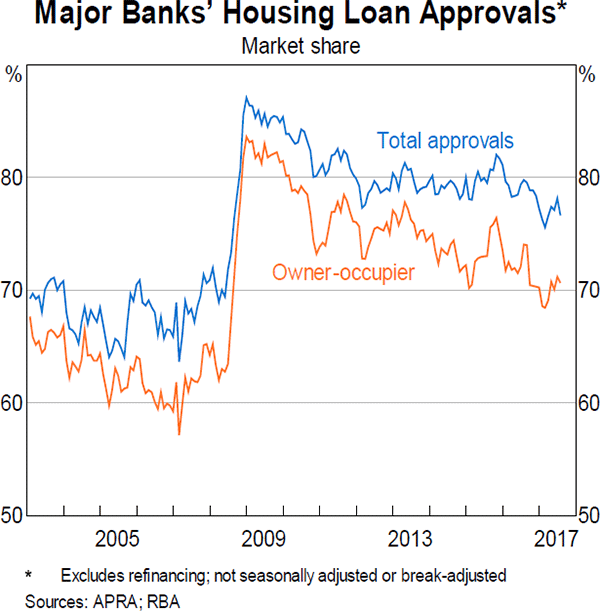
Since the crisis, the major banks' share has declined a little. This has mainly been due to an increase in the shares of incumbent smaller Australian banks, foreign banks and non-ADIs; there have not been any significant new entrants. Some of these lenders, such as non-ADIs, specialise in lending to higher-risk borrowers (Aylmer 2016). The increase in the volume of activity for smaller lenders is likely to improve their economies of scale and capacity to compete. More accurate measurement of the scale of activity undertaken by some non-ADIs in the mortgage market will result from changes to the Financial Sector (Collection of Data) Act 2001.
Increasing use of the broker market to originate loans by smaller lenders and consolidation among credit unions and building societies over recent years are also likely to boost the efficiency of these entities. In contrast, many foreign banks have little or no presence in the Australian mortgage market despite being able to leverage the home-lending infrastructure in their home markets. In the past, new entrants might have found it more costly to set up new retail operations, requiring a branch network and name recognition, than to set up wholesale banking businesses to provide services to existing wholesale clients.
Increased use of brokers by borrowers has resulted in greater competition among lenders via this loan origination channel. Smaller lenders have made greater use of this distribution channel than the major banks because it is lower cost than a branch network (Graph 26). For borrowers, brokers reduce search costs by efficiently comparing deals across lenders. The introduction of a wider range of mortgage products, partly in response to prudential regulations, has increased the benefits for consumers of using brokers.
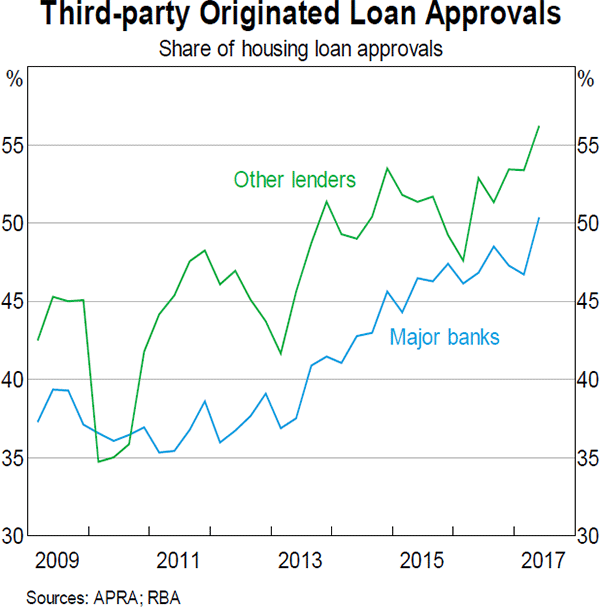
Lending standards
Developments in lending standards have also had an effect on competition recently. As housing credit growth increased after 2012, strong competition for mortgage lending resulted in a weakening in lending standards and increased risk-taking by both housing lenders and borrowers. However, over the past few years banks have reassessed their approach to the risks in mortgage lending. This has been partly driven by prudential regulations designed to reduce risks in the mortgage market, which have been effective in tightening lending standards. It has also been driven by changes in lenders' risk appetite as a result of several developments, including a rise in non-performing loans and a focus on risks of oversupply in some apartment markets. As a consequence of these developments, there has been a broad tightening in lending standards, and reduced supply of credit for various market segments. This includes the investor, non-resident, high-LVR and interest-only segments, as well as some regions.
The major banks were among the lenders that were competing strongly in many of these segments. They, and other lenders, have tightened their lending criteria, raised interest rates and pulled back from higher-risk lending. As they have done so, some smaller lenders (some of which have a lower risk appetite than the major banks), have regained market share, supported by strong ongoing demand for housing credit.
There have been other effects of the tightening in lending standards by ADIs. One has been a reduction in the level of refinancing. This followed a period of very strong growth in refinancing from 2012 through to mid 2015 when lenders, including the major banks, actively competed for each other's existing customers through greater price discounting, fee waivers and cash back for refinanced loans. Another effect has been that some borrowers, such as non-residents, are no longer able to access credit from ADIs and have instead sought credit from non-ADIs.
Price competition
The typical Australian mortgage offered by the major banks is priced with reference to a benchmark standard variable rate (SVR). Major banks typically offer advertised and unadvertised discounts below the benchmark rate, with the discount dependent on factors such as the loan size and LVR, the number of products the customer has with the bank and other borrower or product attributes. Many smaller lenders do not offer unadvertised discounts, partly because of the higher costs involved in negotiating these agreements. Unadvertised discounts also appear to be offered in some overseas mortgage markets, such as in the United Kingdom and Canada.
The difference between the major banks' SVR and the average rate paid by borrowers is significant and has changed through time. Since 2010 the average discount for all loans from a standard variable interest rate on a principal-and-interest loan for an owner-occupier has increased from around 60 basis points to around 90 basis points. The average discount for new borrowers exceeds that of existing borrowers and a large proportion of the discount is unadvertised (Graph 27).
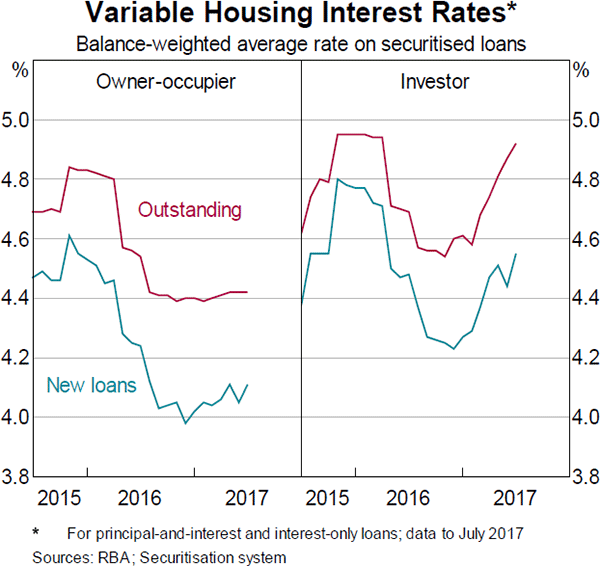
Borrowers' capacity to source the best deal and assess the benefits of switching providers has been assisted by the introduction of brokers and comparison websites. However, it is not clear that there is sufficient transparency in the mortgage market for existing borrowers to easily assess whether they have a good deal or whether they should consider refinancing.
A notable recent development has been a re-emergence of significant variation in interest rates between different borrowers and loan types in the mortgage market, reflecting both regulation and a reassessment of risk (Kent 2017). Lending rates for investors and interest-only borrowers now have a significant premium relative to owner-occupier and principal-and-interest loans. This has in part occurred in response to APRA measures designed to limit the flow of new lending in these categories. However, banks have sought to manage lending flows by adjusting pricing to both new loans and existing loans. The interest rate increases have boosted banks' spread on housing lending and banks' margins, but this at least in part reflects the higher risk of these loans. In contrast, there has reportedly been stronger price competition for owner-occupiers taking principal-and-interest loans.
Small business lending
Unlike the market for large business loans, where competition appears to have intensified recently, competition for small business lending appears not to have changed much since the financial crisis. This is likely to be partly due to the greater structural impediments that this market has to overcome, such as information asymmetries. Comprehensive credit reporting, open data, innovations from new providers of finance that are making greater use of technology, and the government's initiative to increase access to crowdsourced equity financing have the potential to increase competition for small business finance. On the other hand, product bundling and a low level of transparency in lending rate outcomes across different segments of the small businesses loan market are likely to be inhibiting competition.
Defining the small business lending market
Defining the small business segment is somewhat difficult due to the presence of alternative definitions of a small business (Simon and Moore 2015). For ADIs, lending to businesses in amounts lower than $1–2 million dollars is typically categorised as a small business loan. An alternative measure of small business lending is lending to unincorporated businesses.
The business lending market can also be decomposed along a number of dimensions, such as by industry and age of business. The intensity of competition within a particular segment or industry is likely to be influenced by the number and types of lending participants and their risk appetites. While the major banks tend to offer lending products to most segments of the small business loan market, many smaller local and foreign lenders tend to specialise. One example is the large market share in lending to the agricultural sector by foreign banks. Assessing the nature of competition in each of these segments is beyond the scope of this submission.
Credit risk and information costs
The average spread on small business loans is significantly higher than for large business loans. One reason for this is that small businesses are inherently riskier. Another is that the fixed costs to a lender (and borrower) of originating a loan and undertaking a credit risk assessment is a higher proportion of the loan than for a large business.
Some of the higher costs of originating loans and undertaking credit assessments could be overcome through comprehensive credit reporting or open data initiatives. Large businesses typically do not face the same information barriers to financing that small businesses face, since they often have greater regulatory reporting requirements and an established financial track record. Furthermore, the costs of loan origination for a large business are small relative to the revenue generated for the bank by the business. Increased use of brokers by smaller businesses and various forms of government assistance have helped deal with this information problem.
Access to finance
Small businesses surveys tend to indicate that access to finance is currently not seen to be a significant issue. However, it is often a concern for some small businesses that are new or that are seeking to expand (Simon and Moore 2015).
Small businesses have more limited debt financing options than large businesses and this significantly changes the nature of competition for loans. As substitutes for bank loans, large businesses may access syndicated loan or corporate bond markets. Small businesses may source equipment finance from specialist companies and trade credit or they may use personal finance such as credit cards and home loans (Fitzpatrick and Lien 2013; Simon and Moore 2015). Recent innovations in the provision of credit to small businesses by fintech companies appear to have not yet gained much market share (ASIC 2016).
Many small businesses have limited collateral, other than a family home, against which they can secure a loan. At the same time, many banks have a low appetite for lending unsecured to small businesses, partly because of the limited financial data available. Without sufficient equity or collateral, many small businesses will receive only limited loan funding.
Small businesses also have more restricted access to external equity financing than large businesses. In some cases owners are also reluctant to take on external equity finance due to concerns that they will lose control of their business. The government's initiative to widen access to crowdsourced equity financing will improve the range of equity financing options available to some small businesses.
Price competition
The significant repricing of risk on all lending through the financial crisis has been more lasting for small businesses (Graph 28). This is likely to be partly a result of natural barriers to entry to this market. It is notable that in recent years there has been strong competition for large business lending from Asian banks, which has seen the major banks lose share and margin (Graph 28 and Graph 29). This contrasts with the market for small business lending, which remains relatively concentrated and where there has been little overall change in the spread between the average lending rate and the cash rate for a number of years.
There can also be a large dispersion in the interest rates offered to small businesses (RBA 2014b). Among other factors, this is likely to be due to differences in borrower or product risks. However, small businesses face significant search costs in determining whether they have the best deal. A reported increased use of brokers will assist them in reducing these search costs. However, a lack of transparency in lending rate outcomes across small business segments makes it difficult for borrowers to determine whether they have a good deal or the benefits of switching providers.
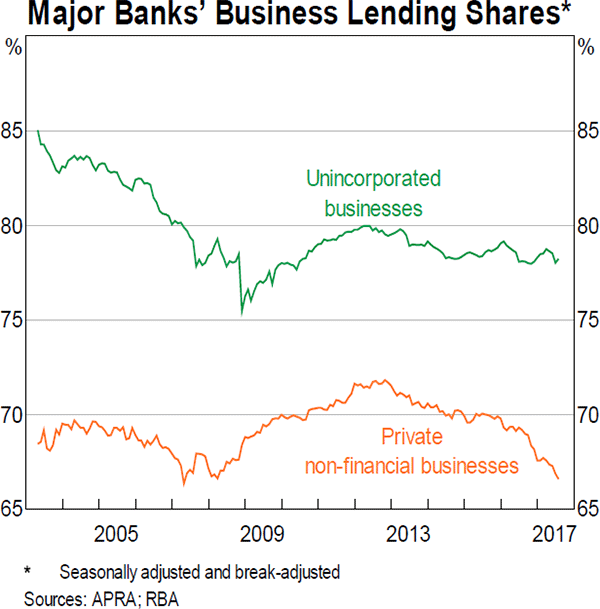
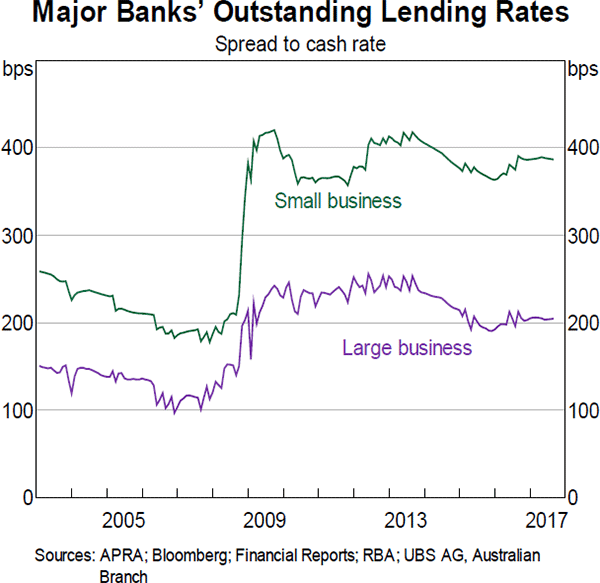
Product bundling
A bank's lending arrangement with a business customer is often only a small part of an overall relationship that involves deposit and transactional banking products (Simon and Moore 2015). Banks have a strong incentive to provide products in addition to loans to small businesses since around 40 per cent of fee income that banks earn from businesses accrues from deposits and merchant services (Fitzpatrick and White 2017).
The ability to bundle products to small businesses is a means by which larger banks can restrict competition, since small businesses may find it more difficult to switch between alternative providers of financial services and obtain competitive prices on all of their products.
Alternatively, product bundling can also reflect other factors such as economies of scope that lower the costs of providing financial services to small businesses. Banks have indicated they have a preference to have lending relationships with small business customers with whom they have transactional banking relationships because they have greater insight into the credit risk associated with that customer. Regulatory changes that provide incentives for banks to source a larger share of more stable funding from retail deposits have also resulted in increased competition for small business deposits.
Brokers and fintech
Small businesses often lack the expertise or resources to identify their financing needs. Increased use of brokers has lowered the search costs and increased price competition in some segments of the small business loans market.
The relatively high interest rates and information barriers faced by small businesses (including search costs) have also stimulated new innovative finance providers. These finance providers seek to reduce the information costs faced by small businesses and lenders by greater use of technology. There are a variety of different models including peer-to-peer, marketplace and payments-based providers. It is apparent that much of the technology locally is replicating models developed in the United States and United Kingdom. However, it is not clear that innovative finance providers have made significant inroads into Australian loan markets.
Some banks have indicated that they are looking into ways in which they might utilise some of the new technology in order to reduce the cost of loan origination for small businesses. This technology might also stimulate the entry of new banks into the small business lending markets, through lowering the cost of risk assessments (and loan origination) or through generating economies of scale (through more efficient loan application processing).
Footnote
The NPP is a new 24-hour payment system that will provide real-time, data rich payments between customer accounts, with simple payment addressing capabilities. The system has been developed by 13 banks (including the Reserve Bank) over several years and is expected to become operational in late 2017. See <www.nppa.com.au>. [10]